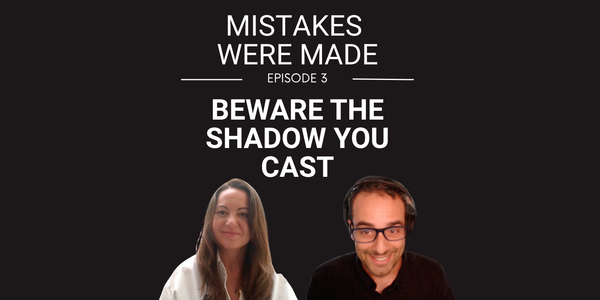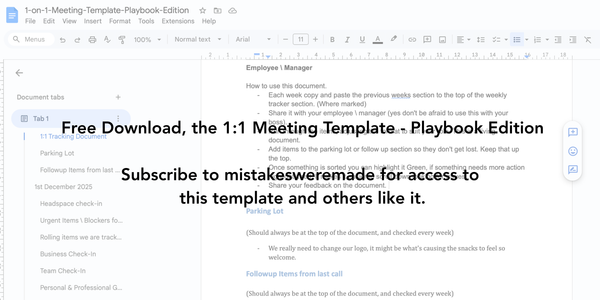One-on-Ones That Actually Work: A Playbook for New Leaders (and everyone else).
One-on-ones are one of the most underappreciated tools in leadership. Too often they drift into glorified status updates, or worse, get cancelled when things get busy. But when they’re done well, they’re the quickest way to build trust, clarity, and momentum in a team.

One-on-ones are one of the most underappreciated tools in leadership. Too often they drift into glorified status updates, or worse, get cancelled when things get busy. But when they’re done well, they’re the quickest way to build trust, clarity, and momentum in a team.
I’ve been on a bit of a quest to model what great 1:1s look like. To me, they’re central to shaping team culture and creating a healthy workplace – though not everyone sees it that way. I have always found it fascinating that Ben Horowitz once received criticism for discussing their importance (worth a read if you haven’t seen the blog post).
By the way! You can download the 1:1 template I use HERE
That’s why I try to bring the topic up in every podcast conversation I have. My aim is to blend my guests’ perspectives with my own experiences, and share what I’m learning about how to run 1:1s that actually matter.
So here is Carlo's guide to running great 1:1s* (With content from all my guests)
1. One-on-Ones Aren’t Forecast Calls
Jeff’s line was blunt: a one-on-one is not the place to review pipeline or go through Jira tickets. That’s management, not leadership. If your 1:1 is just a status update, you’re missing the point.
Instead, the goal is to create a predictable space where your team member feels heard, supported, and stretched.
2. Separate the Two Conversations
Every good 1:1 has two streams:
- Business: How’s the work going? Where are you blocked?
- Growth: How are you going? What skills do you want to build?
Mix them together and you’ll default to the easy stuff – tasks and deadlines – while avoiding the harder, more valuable growth discussions.
3. Coach vs Mentor Mode
Ross drew a clean line that’s changed how I approach these conversations:
- Mentor: Share your lived experience – “Here’s what worked for me and why.”
- Coach: Hold back your opinion – “What outcome do you want? What options do you see?”
The trick is knowing which mode to choose. Repeatable patterns call for a mentor. Fuzzy goals or messy context call for a coach.
4. Ask Better Questions
The quality of your 1:1s is the quality of your questions. Some that work:
- Trust & connection: “What’s one thing outside of work that’s giving you energy (or draining it)?”
- Performance: “Where are you blocked?”
- Growth: “Which of your strengths are you using most right now? Any blind spots showing up?”
- Team health: “What’s one thing we could improve in how the team works together?”
5. Create Variety
Context shapes conversation. Jeff swears by the walking 1:1 – fewer distractions, more openness. Sometimes you’ll want a café chat, sometimes a structured Zoom. The important part is consistency: show up, every time.
6. When Things Get Hard
Performance dips, egos flare, mistakes happen. A good 1:1 is where you surface it early:
- Be direct but empathetic – “I’ve noticed X, how do you see it?”
- Admit your own mistakes. Modelling it makes it safe for others.
- If someone’s struggling, ask whether you’re dealing with a skills gap, a motivation issue, or a context clash.
And if you find yourself spending more energy working around someone than with them, Jeff’s advice was clear: you may be past the point of recovery.
7. Watch for Runways
Roles don’t stay a fit forever. Jeff talked about the “three-year rule” – after three years in the same seat, passion can fade and autopilot sets in. Use your 1:1s to explore new runways: another project, team, or role before things stall.
8. The Cheat Sheet
Before you walk into your next 1:1, run through this quick checklist:
- Did I check in on them as a human first?
- Did they bring their own topics?
- Did I share context or feedback they need?
- Did we talk about growth, not just tasks?
- Did I choose the right hat – mentor or coach?
- Did we both leave with clear next steps?
Final Thought
One-on-ones aren’t glamorous. They don’t make headlines. But in the quiet rhythm of a team, they’re where trust is built, blind spots surface, and growth plans take root.
Or as Jeff put it: “People don’t follow titles, they follow consistency.”




